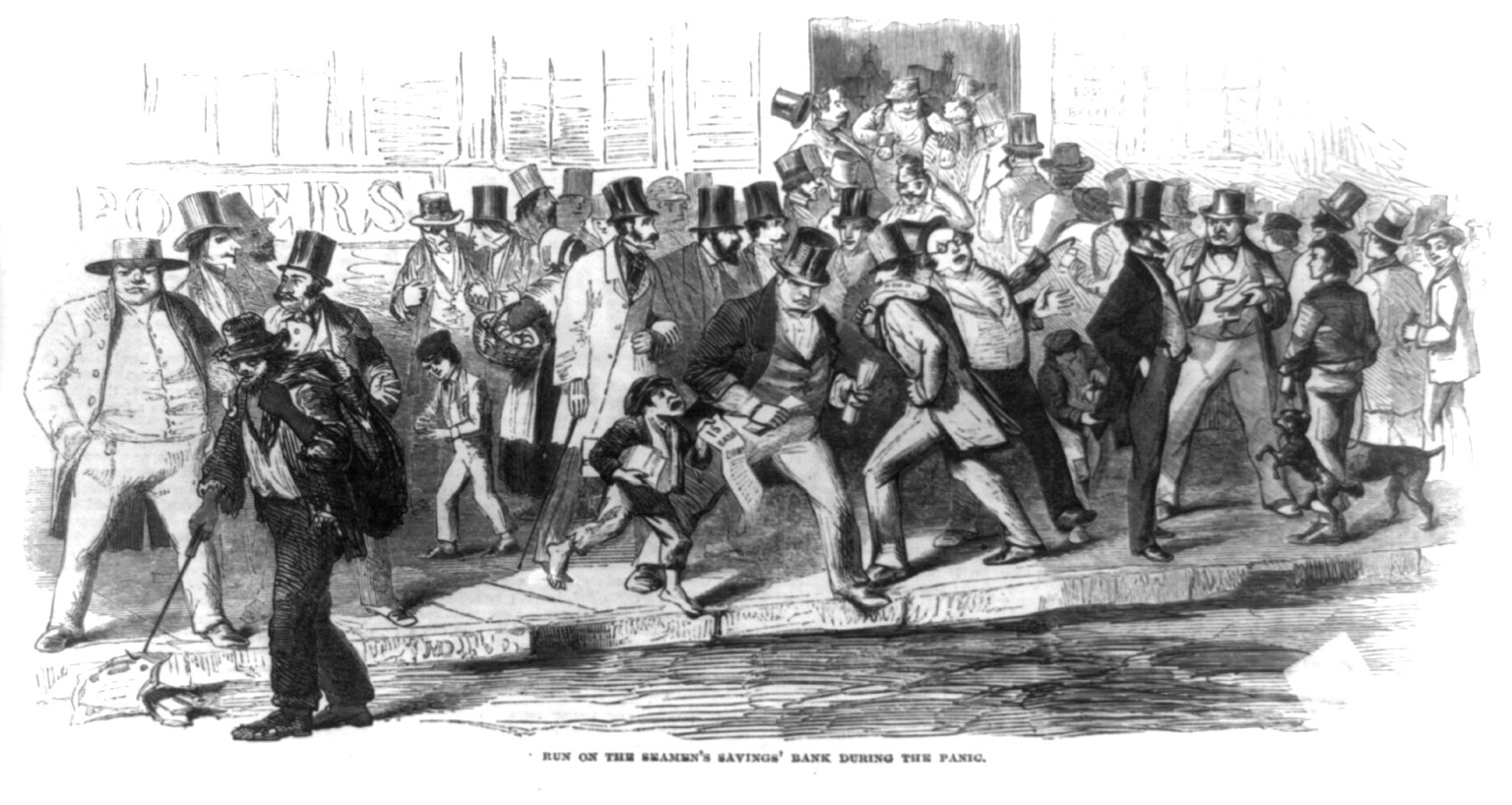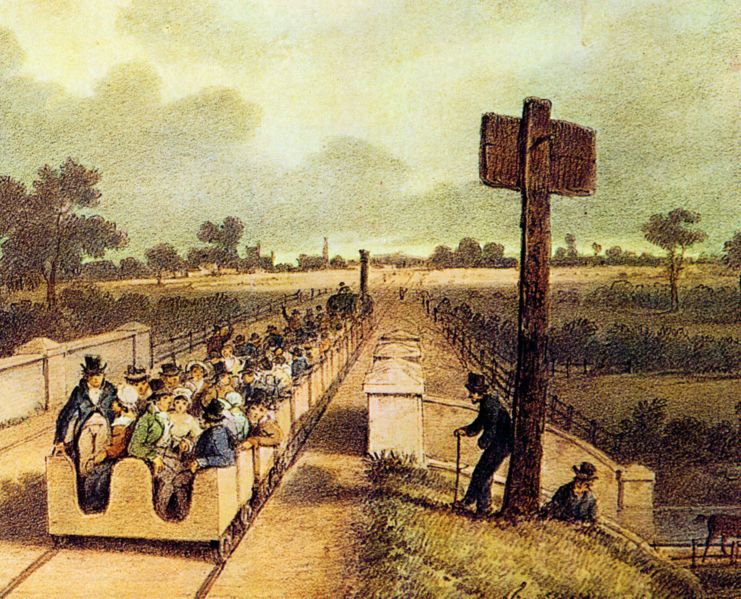|
Paper Railroad
In the United States, a paper railroad is a company in the railroad business that exists "on paper only": as a legal entity which does not own any track, locomotives, or rolling stock. In the early days of railroad construction, paper railroads had to exist by necessity while in the financing stage. It allowed incorporation of a company and the seeking of capital to build a proposed railroad. In the 1850s, speculation of stock of paper railroads became rampant, causing a bubble of their stocks. This led in large part to the Panic of 1857. Throughout the 19th and early 20th centuries, this specific connotation of the phrase "paper railroad" was consistent: a proposed, often speculative (and sometimes wildly speculative) venture in which a company stock exists, but no physical assets to run a railroad do. In many cases, these railroads still existed as corporate entities long after plans to build them had been scrapped. In the context of recent times, the phrase "paper railroad" i ... [...More Info...] [...Related Items...] OR: [Wikipedia] [Google] [Baidu] |
United States
The United States of America (USA), also known as the United States (U.S.) or America, is a country primarily located in North America. It is a federal republic of 50 U.S. state, states and a federal capital district, Washington, D.C. The 48 contiguous states border Canada to the north and Mexico to the south, with the semi-exclave of Alaska in the northwest and the archipelago of Hawaii in the Pacific Ocean. The United States asserts sovereignty over five Territories of the United States, major island territories and United States Minor Outlying Islands, various uninhabited islands in Oceania and the Caribbean. It is a megadiverse country, with the world's List of countries and dependencies by area, third-largest land area and List of countries and dependencies by population, third-largest population, exceeding 340 million. Its three Metropolitan statistical areas by population, largest metropolitan areas are New York metropolitan area, New York, Greater Los Angeles, Los Angel ... [...More Info...] [...Related Items...] OR: [Wikipedia] [Google] [Baidu] |
Company
A company, abbreviated as co., is a Legal personality, legal entity representing an association of legal people, whether Natural person, natural, Juridical person, juridical or a mixture of both, with a specific objective. Company members share a common purpose and unite to achieve specific, declared goals. Over time, companies have evolved to have the following features: "separate legal personality, limited liability, transferable shares, investor ownership, and a managerial hierarchy". The company, as an entity, was created by the State (polity), state which granted the privilege of incorporation. Companies take various forms, such as: * voluntary associations, which may include nonprofit organizations * List of legal entity types by country, business entities, whose aim is to generate sales, revenue, and For-profit, profit * financial entities and banks * programs or educational institutions A company can be created as a legal person so that the company itself has limi ... [...More Info...] [...Related Items...] OR: [Wikipedia] [Google] [Baidu] |
Rail Transport
Rail transport (also known as train transport) is a means of transport using wheeled vehicles running in railway track, tracks, which usually consist of two parallel steel railway track, rails. Rail transport is one of the two primary means of land transport, next to road transport. It is used for about 8% of passenger and rail freight transport, freight transport globally, thanks to its Energy efficiency in transport, energy efficiency and potentially high-speed rail, high speed.Rolling stock on rails generally encounters lower friction, frictional resistance than rubber-tyred road vehicles, allowing rail cars to be coupled into longer trains. Power is usually provided by Diesel locomotive, diesel or Electric locomotive, electric locomotives. While railway transport is capital intensity, capital-intensive and less flexible than road transport, it can carry heavy loads of passengers and cargo with greater energy efficiency and safety. Precursors of railways driven by human or an ... [...More Info...] [...Related Items...] OR: [Wikipedia] [Google] [Baidu] |
Legal Person
In law, a legal person is any person or legal entity that can do the things a human person is usually able to do in law – such as enter into contracts, lawsuit, sue and be sued, ownership, own property, and so on. The reason for the term "''legal'' person" is that some legal persons are not human persons: Company, companies and corporations (i.e., business entities) are ''persons'', legally speaking (they can legally do most of the things an ordinary person can do), but they are not, in a literal sense, human beings. Legal personhood is a prerequisite to capacity (law), legal capacity (the ability of any legal person to amend – i.e. enter into, transfer, etc. – rights and Law of obligations, obligations): it is a prerequisite for an international organization being able to sign treaty, international treaties in its own legal name, name. History The concept of legal personhood for organizations of people is at least as old as Ancient Rome: a variety of Coll ... [...More Info...] [...Related Items...] OR: [Wikipedia] [Google] [Baidu] |
Rail Tracks
Railway track ( and UIC terminology) or railroad track (), also known as permanent way () or "P way" ( and Indian English), is the structure on a railway or railroad consisting of the rails, fasteners, sleepers ( railroad ties in American English) and ballast (or slab track), plus the underlying subgrade. It enables trains to move by providing a dependable, low-friction surface on which steel wheels can roll. Early tracks were constructed with wooden or cast-iron rails, and wooden or stone sleepers. Since the 1870s, rails have almost universally been made from steel. Historical development The first railway in Britain was the Wollaton wagonway, built in 1603 between Wollaton and Strelley in Nottinghamshire. It used wooden rails and was the first of about 50 wooden-railed tramways built over the subsequent 164 years. These early wooden tramways typically used rails of oak or beech, attached to wooden sleepers with iron or wooden nails. Gravel or small stones were pa ... [...More Info...] [...Related Items...] OR: [Wikipedia] [Google] [Baidu] |
Locomotives
A locomotive is a rail vehicle that provides the motive power for a train. Traditionally, locomotives pulled trains from the front. However, push–pull operation has become common, and in the pursuit for longer and heavier freight trains, companies are increasingly using distributed power: single or multiple locomotives placed at the front and rear and at intermediate points throughout the train under the control of the leading locomotive. Etymology The word ''locomotive'' originates from the Latin 'from a place', ablative of 'place', and the Medieval Latin 'causing motion', and is a shortened form of the term ''locomotive engine'', which was first used in 1814 to distinguish between self-propelled and stationary steam engines. Classifications Prior to locomotives, the motive force for railways had been generated by various lower-technology methods such as human power, horse power, gravity or stationary engines that drove cable systems. Few such systems are sti ... [...More Info...] [...Related Items...] OR: [Wikipedia] [Google] [Baidu] |
Rolling Stock
The term rolling stock in the rail transport industry refers to railway vehicles, including both powered and unpowered vehicles: for example, locomotives, Railroad car#Freight cars, freight and Passenger railroad car, passenger cars (or coaches), and Railroad car#Non-revenue cars, non-revenue cars. Passenger vehicles can be un-powered, or self-propelled, Railcar, single or Multiple unit, multiple units. In North America, Australia and other countries, the term consist ( ) is used to refer to the rolling stock comprising a train, a list containing specific information for each car of a train, or a group of locomotives. In the United States, the term ''rolling stock'' has been expanded from the older broadly defined "trains" to include wheeled vehicles used by businesses on roadways. The word ''stock'' in the term is used in a sense of inventory. Rolling stock is considered to be a liquid asset, or close to it, since the value of the vehicle can be readily estimated and then ship ... [...More Info...] [...Related Items...] OR: [Wikipedia] [Google] [Baidu] |
Panic Of 1857
The Panic of 1857 was a financial crisis in the United States caused by the declining international economy and over-expansion of the domestic economy. Because of the invention of the telegraph Telegraphy is the long-distance transmission of messages where the sender uses symbolic codes, known to the recipient, rather than a physical exchange of an object bearing the message. Thus flag semaphore is a method of telegraphy, whereas ... by Samuel F. Morse in 1844, the Panic of 1857 was the first financial crisis to spread rapidly throughout the United States. The world economy was more interconnected by the 1850s, which made the Panic of 1857 the first worldwide economic crisis. In Britain, the Henry John Temple, 3rd Viscount Palmerston, Palmerston government circumvented the requirements of the Bank Charter Act 1844, which required gold and silver reserves to back up the amount of money in circulation. Surfacing news of this circumvention set off the Panic in Britain. B ... [...More Info...] [...Related Items...] OR: [Wikipedia] [Google] [Baidu] |
Subsidiary
A subsidiary, subsidiary company, or daughter company is a company (law), company completely or partially owned or controlled by another company, called the parent company or holding company, which has legal and financial control over the subsidiary company. Unlike regional branches or divisions, subsidiaries are considered to be distinct entities from their parent companies; they are required to follow the laws of where they are incorporated, and they maintain their own executive leadership. Two or more subsidiaries primarily controlled by same entity/group are considered to be sister companies of each other. Subsidiaries are a common feature of modern business, and most multinational corporations organize their operations via the creation and purchase of subsidiary companies. Examples of holding companies are Berkshire Hathaway, Jefferies Financial Group, The Walt Disney Company, Warner Bros. Discovery, and Citigroup, which have subsidiaries involved in many different Industry (e ... [...More Info...] [...Related Items...] OR: [Wikipedia] [Google] [Baidu] |
Operating Subsidiary
An operating subsidiary is a subsidiary of a corporation through which the parent company (which may or may not be a holding company) indirectly conducts some portion of its business. Usually, an operating subsidiary can be distinguished in that even if its board of directors and officers overlap with those of other entities in the same corporate group, it has at least some officers and employees who conduct business operations primarily on behalf of the subsidiary alone (that is, they work directly for the subsidiary). The term carries slightly different meanings depending upon the specific context and industry. A non-operating subsidiary, in contrast, is a subsidiary that exists on paper, but does not have any assets or employees of its own and therefore cannot function independently as a going business concern. Thus, its only actual business "operations" may consist of its officers entering into contracts with other corporate entities (which may or may not be within the sam ... [...More Info...] [...Related Items...] OR: [Wikipedia] [Google] [Baidu] |
Railway Mania
Railway Mania was a stock market bubble in the rail transportation industry of the United Kingdom of Great Britain and Ireland in the 1840s. It followed a common pattern: as the price of railway shares increased, speculators invested more money, which further increased the price of railway shares, until the share price collapsed. The mania reached its zenith in 1846, when 263 Acts of Parliament for setting up new railway companies were passed, with the proposed routes totalling . About a third of the railways authorised were never built—the companies either collapsed because of poor financial planning, were bought out by larger competitors before they could build their line, or turned out to be fraudulent enterprises to channel investors' money into other businesses. Causes The world's first recognizably modern inter-city railway, the Liverpool and Manchester Railway (the L&M), opened in 1830 and proved to be successful for transporting both passengers and freight. In t ... [...More Info...] [...Related Items...] OR: [Wikipedia] [Google] [Baidu] |




